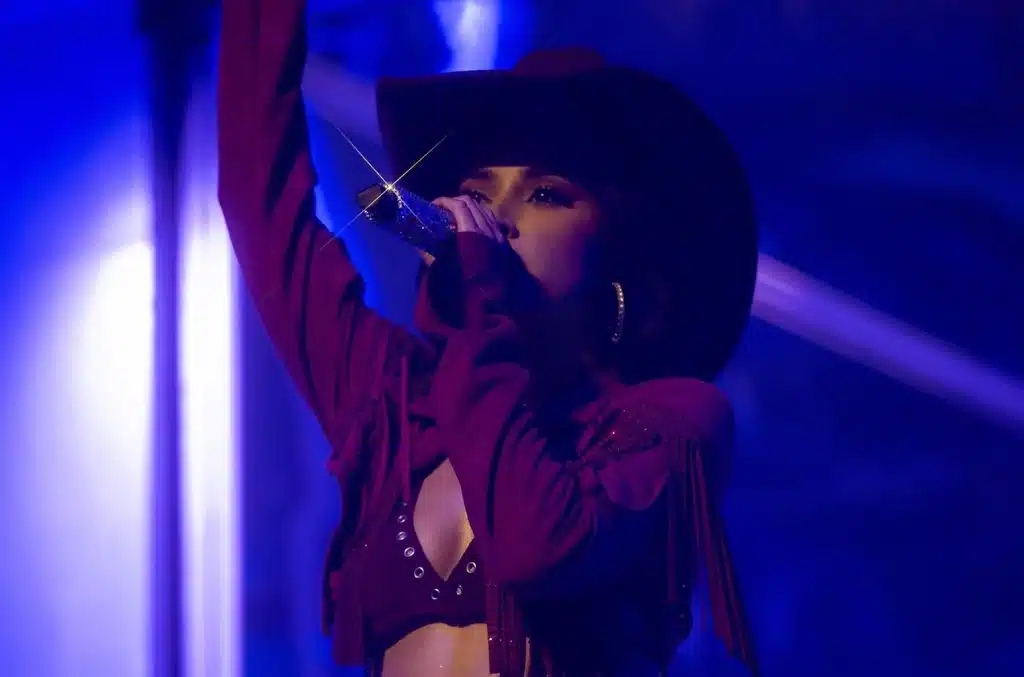selena quintanilla
With her bubbly charm, dazzling aura and universal appeal, Selena Quintanilla revolutionized the Tejano genre in the ‘80s and ‘90s by lacing her authentic Mexican roots with bold new sounds such as R&B, pop, dance and rock. Known as the Queen of Tejano, she shattered ceilings in a genre that was dominated by men, and made history along the way. After earning four of her eventual seven No. 1 Hot Latin Songs hits in 1994 — “Donde Quieras Que Estes,” “Amor Prohibido,” “Bidi Bidi Bom Bom,” and “No Me Queda Más” — the Mexican-American powerhouse was well on her way to a major mainstream crossover before she was tragically shot dead on March 31, 1995, at the age of 23.
Explore
See latest videos, charts and news
See latest videos, charts and news
However, her music has stood the test of time — and, throughout the years, she’s influenced a new generation of hitmakers, making her a bona fide Latin icon in pop culture 30 years later. As a testament to her enduring legacy, Mexican-American artist Becky G speaks with Billboard about her love and admiration for Selena, and how she’s influenced her own career. Read her heartfelt as-told-to essay below:
Trending on Billboard
I was born in 1997. That was two years after Selena’s passing.
My mom actually remembers when they were doing the casting calls for the movie…she actually wanted to audition. Everyone loved Selena and identified with her. Having such a young mom, she naturally played for me the music she would listen to. I may not have vivid memories of Selena, but this is the way she was introduced to me. I even have baby videos listening to her music. She’s always been a part of my life.
She’s influenced my career in so many ways. As a performer, she represented so much more than just herself. She started building a bridge for the 200 percenters like myself, who [are] no eran de aqui ni de alla (neither from here nor from there). Growing up, that identity crisis used to feel like such a curse for me. I felt that I wasn’t enough, and I felt that I had to sacrifice parts of myself to be accepted on this or that side. What Selena embodied was authenticity. She was so authentic in her sense of humor, the dreams that she had, and the way she connected with her family and fans. That’s something that we, as fans, crave today from our favorite artists, but it’s a lot easier said than done.
At Coachella in 2023, I decided to pay tribute to her. A part of me does it for Little Becky, because I think what Little Becky saw in Selena was that dreams can come true, and it’s almost a celebration of being here and of her. First and foremost, I think it’s important that we recognize who came before us, and for me, it’s a beautiful thing to pay respect to the people you know you wouldn’t be here without. I truly feel that I wouldn’t be here without Selena.
Throughout the years, I’ve been very blessed to have had many, many loving interactions with the Quintanillas. Suzette even became a pretty good friend of mine. This last tour that I was on, she came to see it, and she’s always been super supportive. I actually met [her] mom and dad at the Fiesta de la Flor Festival in Corpus Christi, and I’ll never forget that her dad couldn’t believe that I was going to perform without a band. I was just getting started! It’s always one of those things that he would tease me about. It’s been really cool to keep up with them. They’re truly dedicated to continuing her legacy, and I admire that about them.
Now, going back to the word authenticity, she represents something that still resonates and is relevant today, which is that 200 percent identity. You should always be yourself no matter what, pochos and all! I feel that from the way she showed up in interviews to the way she did some of her most iconic performances to personal stories you hear from her loved ones, there was a common thread: it was her genuine kindness.
As an artist, you are overworked, you are depleted of your energy… but when you’re meant for it, you really do it with gratitude. Selena lived in abundance and was always giving back to the community, and always had the best of intentions. So many artists throughout the years since her passing may have reminded us of her essence, but there will never be another Selena. She was one of a kind — and that’s what makes a true superstar. Selena’s legacy is to admire, to respect, and to continue protecting, because she’s a light to so many of us.
With her bubbly charm, dazzling aura and universal appeal, Selena Quintanilla revolutionized the Tejano genre in the ‘80s and ‘90s by lacing her authentic Mexican roots with bold new sounds such as R&B, pop, dance and rock. Known as the Queen of Tejano, she shattered ceilings in a genre that was dominated by men, and made history along the way. After earning two of her eventual four No. 1 Latin Airplay hits in 1994 — “Bidi Bidi Bom Bom” and “No Me Queda Más” — the Mexican-American powerhouse was well on her way to a major mainstream crossover before she was tragically shot dead on March 31, 1995, at the age of 23.
Explore
See latest videos, charts and news
See latest videos, charts and news
However, her music has stood the test of time and, throughout the years, she’s influenced a new generation of hitmakers, making her a bona fide Latin icon in pop culture 30 years later. As a testament to her enduring legacy, Argentine artist Maria Becerra speaks with Billboard about her love and admiration for Selena, and how she’s influenced her own career. Read her heartfelt as-told-to essay below:
Trending on Billboard
I discovered Selena when I was very young, about 10 years old, specifically with “Como La Flor.” It was the song that had the greatest impact on me since I was a child, and I loved it because it generated a ton of emotions. My family is very much into cumbias. Her music was always playing at all our parties. My mom played her records in the house, and she was always an artist who moved me a lot, with her feelings when she sang and what the songs said.
When I started my musical career at 19, I connected with her even more because watching her interviews, I fell in love with her personality, how she treated people, and the light she had when she spoke. I feel like she was one of those people who walked through the door and you couldn’t help but notice her presence. I saw her movie, her series, I have several of her vinyls, and she’s been a huge inspiration for me, in my outfits, in the sounds I use in my cumbias, the type of lyrics I do. [My music] is all a tribute to her.
Her audience was mostly Mexican, but also throughout Latin America. She managed to break down those barriers, but sadly, after her death, she became a phenomenon, although she was always one.
Maria Becerra
Javier Rogoski
I remember the day I met her brother, A.B., at the Latin Grammys [in 2021]. It was the first one I went to where I was nominated for Best New Artist, and I was blown away. I couldn’t believe it. He’s amazing! He told me, “You remind me so much of my sister, the way you talk, the way you laugh, how nice you are”—and I’ll never forget those words. It was the best compliment I’ve ever received in my entire life. He told me he really wanted to make music with me, and I know life will bring us together. That would be wonderful for music.
About three years ago, I really got caught up in a loop watching her interviews, seeing how beautiful she was, and I really wish I could have met her… everything a fan feels. I grew closer and closer to her, admired her more, loved her more, and in 2022, I decided to inspire my own concert looks in her outfits. Honestly, it feels so beautiful to be able to pay tribute to her. She’s my reference when I go to the studio, and I like feeling connected to her. I got to the point where my love for her grew more and more that I wanted to get her tattooed. I want to have her marked on my skin because she left a deep impression on me.
She demonstrated so much by being the daughter of Mexican parents and always carrying her culture forward. That makes me feel so proud of the kind person she was and how she kept those values intact. She said: I’m going to move forward without forgetting where I’m from, and that seems very magical to me. It touched me beyond her kindness and her incredible talent. For all Latinos, Selena is that… she is culture, she is roots, she is love. She’s love for your homeland and your culture.

Whether it was on a red carpet, sold-out concer, or in a music video — rocking her cow-printed vest and miniskirt or bedazzled bustiers — Selena Quintanilla’s fashion-forward style always shined. Now, one of her most emblematic outfits is part of the Smithsonian National Museum of American History’s “Entertainment Nation” exhibition.
Explore
See latest videos, charts and news
See latest videos, charts and news
Marking the Smithsonian’s first dedicated exploration of entertainment history, the exhibition features approximately 200 objects that honor theater, television, film, music and sports, including Quintanilla’s leather jacket and satin brassiere combo that she wore at the 1994 Tejano Music Awards in San Antonio, Texas. Quintanilla wore the outfit on display to perform a medley of “Donde Quiera Que Estés” with the Barrio Boyzz and “Bidi Bidi Bom Bom.” That same year, she won female artist of the year, female entertainer of the year, and album of the year for Selena Live!
The rockstar-inspired ‘fit was donated to the museum by the Quintanilla family in 1998.
“This costume is on display on a red carpet, so it’s kind of a spotlight moment to explore Selena, her legacy, the impact that she had,” Ashley Mayor, a curatorial assistant who worked on the exhibition, tells Billboard via email. “It’s important to explore the impact of Selena on a generation of young Latinos who dreamed of being like her. She affected so many people with her music and brought Tejano music to a national and international level. She became a phenomenon.”
Courtesy of the National Museum of American History
In August, the Quintanilla family released Selena’s new posthumous album Moonchild Mixes, home to 10 previously unreleased songs that the Queen of Tejano recorded between the ages of 13 and 16. In an interview with Billboard, her father Abraham Quintanilla Jr. said releasing the album is a way to keep her memory and legacy alive.
The album debuted at No. 1 on Billboard’s Latin Pop Albums chart (dated Sept. 10), as well as at No. 2 on Regional Mexican Albums and No. 8 on the all-Latin-encompassing Top Latin Albums chart. It earned the late icon her seventh No. 1 on Latin Pop Albums, tying Shakira and Thalia for the most among women, and extended her record for the most total weeks spent atop the chart.
-
Pages

 State Champ Radio
State Champ Radio 


